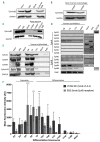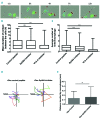Ephrin/Eph receptor interaction facilitates macrophage recognition of differentiating human erythroblasts
- PMID: 31197068
- PMCID: PMC7109712
- DOI: 10.3324/haematol.2018.215160
Ephrin/Eph receptor interaction facilitates macrophage recognition of differentiating human erythroblasts
Abstract
Erythropoiesis is one of the most efficient cellular processes in the human body producing approximately 2.5 million red blood cells every second. This process occurs in a bone marrow niche comprised of a central resident macrophage surrounded by differentiating erythroblasts, termed an erythroblastic island. It is not known what initially attracts the macrophage to erythroblasts to form these islands. The ephrin/Eph receptor family are known to regulate heterophilic cell-cell adhesion. We find that human VCAM1+ and VCAM1- bone marrow macrophages and in vitro cultured macrophages are ephrin-B2 positive, whereas differentiating human erythroblasts express EPHB4, EPHB6 and EPHA4. Furthermore, we detect a rise in integrin activation on erythroblasts at the stage at which the cells bind which is independent of EPH receptor presence. Using a live cell imaging assay, we show that specific inhibitory peptides or shRNA depletion of EPHB4 cause a significant reduction in the ability of macrophages to interact with erythroblasts but do not affect integrin activation. This study demonstrates for the first time that EPHB4 expression is required on erythroblasts to facilitate the initial recognition and subsequent interaction with macrophages, alongside the presence of active integrins.
Copyright© 2020 Ferrata Storti Foundation.
Figures






Similar articles
-
Attenuation of eph receptor kinase activation in cancer cells by coexpressed ephrin ligands.PLoS One. 2013 Nov 29;8(11):e81445. doi: 10.1371/journal.pone.0081445. eCollection 2013. PLoS One. 2013. PMID: 24348920 Free PMC article.
-
Very late activation antigen 4-vascular cell adhesion molecule 1 interaction is involved in the formation of erythroblastic islands.J Exp Med. 1995 Jan 1;181(1):411-5. doi: 10.1084/jem.181.1.411. J Exp Med. 1995. PMID: 7528776 Free PMC article.
-
Aberrant DNA methylation and epigenetic inactivation of Eph receptor tyrosine kinases and ephrin ligands in acute lymphoblastic leukemia.Blood. 2010 Mar 25;115(12):2412-9. doi: 10.1182/blood-2009-05-222208. Epub 2010 Jan 8. Blood. 2010. PMID: 20061560 Free PMC article.
-
Roles of Eph receptors and ephrins in segmental patterning.Philos Trans R Soc Lond B Biol Sci. 2000 Jul 29;355(1399):993-1002. doi: 10.1098/rstb.2000.0635. Philos Trans R Soc Lond B Biol Sci. 2000. PMID: 11128993 Free PMC article. Review.
-
The erythroblastic island as an emerging paradigm in the anemia of inflammation.Immunol Res. 2015 Dec;63(1-3):75-89. doi: 10.1007/s12026-015-8697-2. Immunol Res. 2015. PMID: 26376896 Free PMC article. Review.
Cited by
-
Defining the proteomic landscape of cultured macrophages and their polarization continuum.Immunol Cell Biol. 2023 Nov-Dec;101(10):947-963. doi: 10.1111/imcb.12687. Epub 2023 Sep 11. Immunol Cell Biol. 2023. PMID: 37694300 Free PMC article.
-
Glomerular Endothelial Cells Are the Coordinator in the Development of Diabetic Nephropathy.Front Med (Lausanne). 2021 Jun 18;8:655639. doi: 10.3389/fmed.2021.655639. eCollection 2021. Front Med (Lausanne). 2021. PMID: 34222276 Free PMC article.
-
Macrophages: key players in erythrocyte turnover.Hematol Transfus Cell Ther. 2022 Oct-Dec;44(4):574-581. doi: 10.1016/j.htct.2022.07.002. Epub 2022 Aug 28. Hematol Transfus Cell Ther. 2022. PMID: 36117137 Free PMC article. Review.
-
Role of Macrophages in Sickle Cell Disease Erythrophagocytosis and Erythropoiesis.Int J Mol Sci. 2023 Mar 28;24(7):6333. doi: 10.3390/ijms24076333. Int J Mol Sci. 2023. PMID: 37047304 Free PMC article. Review.
-
EKLF/KLF1 expression defines a unique macrophage subset during mouse erythropoiesis.Elife. 2021 Feb 11;10:e61070. doi: 10.7554/eLife.61070. Elife. 2021. PMID: 33570494 Free PMC article.
References
-
- Socolovsky M. Exploring the erythroblastic island. Nat Med. 2013;19(4):399–401. - PubMed
-
- Hanspal M, Hanspal JS. The association of erythroblasts with macrophages promotes erythroid proliferation and maturation: a 30-kD heparin-binding protein is involved in this contact. Blood. 1994;84(10):3494–3504. - PubMed
-
- Toda S, Segawa K, Nagata S. MerTK-mediated engulfment of pyrenocytes by central macrophages in erythroblastic islands. Blood. 2014;123(25):3963–3971. - PubMed
-
- Soni S, Bala S, Gwynn B, Sahr KE, Peters LL, Hanspal M. Absence of Erythroblast Macrophage Protein (Emp) Leads to Failure of Erythroblast Nuclear Extrusion. J Biol Chem. 2006;281(29):20181–20189. - PubMed
Publication types
MeSH terms
Substances
Grants and funding
LinkOut - more resources
Full Text Sources
Research Materials
Miscellaneous

